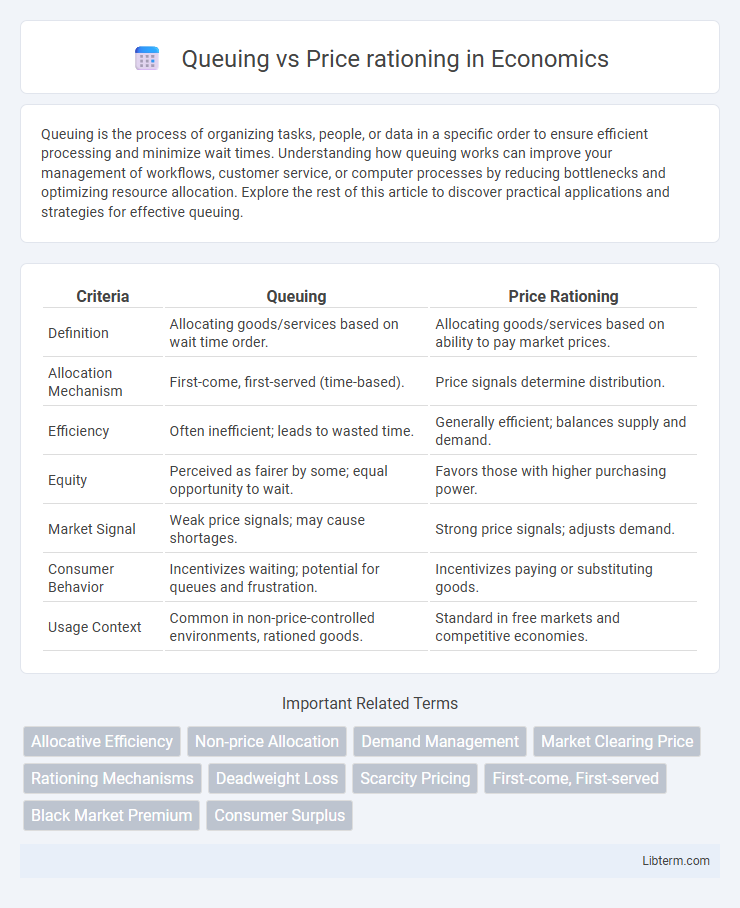Queuing is the process of organizing tasks, people, or data in a specific order to ensure efficient processing and minimize wait times. Understanding how queuing works can improve your management of workflows, customer service, or computer processes by reducing bottlenecks and optimizing resource allocation. Explore the rest of this article to discover practical applications and strategies for effective queuing.
Table of Comparison
| Criteria | Queuing | Price Rationing |
|---|---|---|
| Definition | Allocating goods/services based on wait time order. | Allocating goods/services based on ability to pay market prices. |
| Allocation Mechanism | First-come, first-served (time-based). | Price signals determine distribution. |
| Efficiency | Often inefficient; leads to wasted time. | Generally efficient; balances supply and demand. |
| Equity | Perceived as fairer by some; equal opportunity to wait. | Favors those with higher purchasing power. |
| Market Signal | Weak price signals; may cause shortages. | Strong price signals; adjusts demand. |
| Consumer Behavior | Incentivizes waiting; potential for queues and frustration. | Incentivizes paying or substituting goods. |
| Usage Context | Common in non-price-controlled environments, rationed goods. | Standard in free markets and competitive economies. |
Introduction to Queuing and Price Rationing
Queuing and price rationing are two mechanisms used to allocate scarce resources among competing consumers. Queuing allocates goods or services based on a first-come, first-served basis, often resulting in long waiting lines but ensuring equal access regardless of income. Price rationing, on the other hand, uses price adjustments to balance supply and demand, allowing those willing and able to pay more to receive the resource promptly while controlling overall consumption.
Understanding the Basics of Rationing Methods
Queuing and price rationing are fundamental rationing methods used to allocate scarce resources efficiently. Queuing prioritizes access based on waiting time, often leading to longer queues without adjusting demand, while price rationing uses price signals to balance supply and demand by incentivizing consumers to adjust their consumption based on cost. Understanding these methods is crucial for evaluating their impact on resource distribution, consumer behavior, and market efficiency.
How Queuing Works in Resource Allocation
Queuing allocates resources based on the order of arrival, creating a first-come, first-served system that prioritizes consumers who are willing to wait. This method reduces transaction costs and simplifies allocation when prices are difficult to change or goods are in fixed supply. However, queuing can lead to inefficiencies such as time wasted waiting and potential underutilization of resources compared to price rationing.
The Mechanics of Price Rationing
Price rationing operates through the adjustment of prices to balance supply and demand, where higher prices reduce demand and allocate scarce goods to consumers willing to pay more. This mechanism incentivizes producers to increase supply, ensuring resources flow to their most valued uses based on consumers' willingness to pay. Unlike queuing, which allocates goods based on time spent waiting, price rationing employs market signals to efficiently distribute products and services.
Economic Efficiency: Queuing vs Price Rationing
Queuing leads to inefficiencies by causing longer wait times and wasted resources, as consumers may value time differently but are treated equally, resulting in suboptimal allocation of goods. Price rationing allocates goods based on willingness and ability to pay, promoting economic efficiency by directing products to those who value them most. However, price rationing may exclude lower-income consumers, whereas queuing provides equal access but at the cost of efficiency.
Fairness and Equity Considerations
Queuing allocates resources based on time waited, often perceived as fair because everyone waits their turn, but it can disadvantage those with less time or flexibility. Price rationing uses market prices to allocate goods, promoting efficiency but potentially reducing equity by favoring wealthier individuals. Both mechanisms present trade-offs between fairness and equity, requiring careful policy design to balance access and economic efficiency.
Real-World Examples of Queuing Systems
Queuing systems appear prominently in real-world scenarios such as airport security checkpoints, where passengers wait in line for screening, and hospitals managing patient intake during peak hours. Businesses like popular restaurants and government offices also utilize queuing to allocate limited resources fairly when demand exceeds supply. Unlike price rationing, which adjusts allocation based on consumer willingness to pay, queuing relies on a first-come, first-served approach to manage access and avoid discrimination based on financial capability.
Case Studies: Price Rationing in Action
Case studies of price rationing demonstrate how markets efficiently allocate scarce goods by adjusting prices based on demand, such as during airline ticket sales where dynamic pricing balances seat availability with consumer willingness to pay. In contrast, queuing, as observed in product launches like limited-edition sneakers, often leads to long wait times and inefficiencies, creating opportunities for secondary markets and scalping. Price rationing reduces temporal costs and ensures resources reach consumers who value them most, as proven by studies in housing markets and healthcare services.
Advantages and Disadvantages of Each Approach
Queuing offers the advantage of simplicity and fairness by allocating goods or services based on arrival order, but it often leads to inefficiencies like wasted time and potential exclusion of those unable to wait. Price rationing efficiently allocates resources by balancing supply and demand through market signals, maximizing economic efficiency, yet it may disadvantage lower-income individuals who cannot afford higher prices. Each approach reflects trade-offs between equity and efficiency, influencing access and resource allocation outcomes in different economic contexts.
Choosing the Optimal Rationing Method
Choosing the optimal rationing method depends on market conditions and efficiency goals, with queuing often favored for its simplicity in managing limited supplies during shortages, while price rationing allocates goods based on willingness and ability to pay, maximizing economic efficiency. Queuing may lead to longer wait times and potential inefficiencies, whereas price rationing can result in equitable resource distribution through market-driven price adjustments. Analyzing factors such as consumer surplus, administrative costs, and demand elasticity helps determine the most effective rationing mechanism for specific economic contexts.
Queuing Infographic

 libterm.com
libterm.com